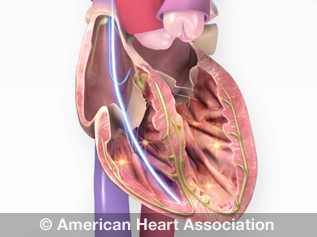Living With Your Implantable Cardioverter Defibrillator (ICD)
You may find living with an ICD scary, especially if you made the decision quickly due to sudden cardiac arrest (SCA). You need to know that you are not alone or without support.
Fortunately, research has shown that ICDs can extend life and improve quality of life. You may live more confidently with an ICD by understanding more about the conditions that led to the implantation, the device itself and what to expect from having it.
Learn more about living with your ICD
Taking medications
Medications are part of your treatment plan that includes your ICD, so take medications exactly as instructed.
- Medications work with your ICD and help your heart pump regularly.
- Keep records of which medications you take and when. Print a medication tracker (PDF).
- Learn more about arrhythmia medications in general.
Understanding and maintaining your device
- Make sure you understand your device and all instructions.
- Your ICD should be checked regularly to find out how the wires are working, how the battery is doing, and how your condition and any external devices have affected the ICD’s performance.
- Your health care professional may check your ICD several times a year by office visit, over the phone or through an Internet connection.
- ICD batteries last five to seven years.
- Your health care professional uses a special analyzer to detect the first warning that the batteries are running down before you notice any changes yourself.
- Eventually your ICD or battery may need to be replaced in a surgical procedure. The replacement procedure is less involved than the original implantation procedure. Your health care team can explain it to you.
- Feel free to take baths and showers. Your ICD is completely protected against contact with water.
- Stay away from magnets and strong electrical fields and tell airport or other screeners that you have an ICD.
- Tell your other doctors, nurses, medical technicians, hospital staff and dentists that you have an ICD.
Follow activity instructions
- Follow the restrictions on activity and any other recommendations from your health care professional.
- Allow about six weeks for your ICD to settle firmly in place. During this time, avoid sudden, jerky or violent actions that will cause your arm to pull away from your body.
- Avoid causing pressure over the area of your chest where your ICD was put in.
- After three weeks, women may find it more comfortable to wear a small pad over the incision as protection from their bra strap.
- Car, train or airplane trips should pose no danger.
- You cannot drive commercially when you have an ICD.
- While you can probably drive about a week after your implantation surgery, your health care professional will be the one to give you the green light. If you received an ICD due to certain conditions, such as having had sudden cardiac arrest or fainting, your health care professional and some state laws may require you to wait six months after you last fainted before driving again. Fainting is a possibility even after implantation of an ICD.
- Be physically active every day. Do whatever you enjoy. Take a short walk or simply move your arms and legs to help your circulation.
- Ask your health care professional about how and when to increase activity. You should wait at least one month before lifting heavy items or doing any high-impact activity. Ask your health care professional about engaging in sports since some can damage or dislodge your ICD or wires.
- Within a few days of surgery, you may be able to perform all your normal activities other than the heavy lifting and high-impact activities as mentioned previously. Once your health care professional allows it, you can probably return to strenuous activities. Always ask your health care team.
- Don’t overdo it. Quit before you get tired. The proper amount of activity should make you feel better, not worse.
Carry your ICD wallet ID card
Don’t leave home without it.
- Download a printable Implantable Cardioverter Defibrillator (ICD) Wallet ID card (PDF).
- Always keep it with you in case of an accident so emergency personnel can treat you appropriately.
- Security devices in public places may detect the metal in your ICD, although they won’t damage it. Showing your card may save you some inconvenience.
- Consider getting a medical ID bracelet or necklace for additional security and convenience.
Symptoms of anxiety, depression and posttraumatic stress disorder (PTSD)
After ICD implantation, you may feel anxious or depressed. This is not uncommon for ICD recipients, especially in the first months or year after implantation. If you experience these feelings, consult with your health care team and get help. There’s no reason to feel embarrassed by or alone with your feelings. By asking questions and expressing your concerns about the ICD and your reactions to it, you might prevent or lessen potential anxiety or depression.
Exposure to a traumatic life-or-death experience is a key to diagnosing PTSD. You may not think of yourself as having PTSD, but having sudden cardiac arrest, multiple shocks or other near-death situations can bring about PTSD symptoms. Do not hesitate to discuss your feelings regarding the trauma with your health care team. Your mental and emotional well-being is important to your physical well-being.
View and print our Answers by Heart sheet: What is an ICD? (PDF)






